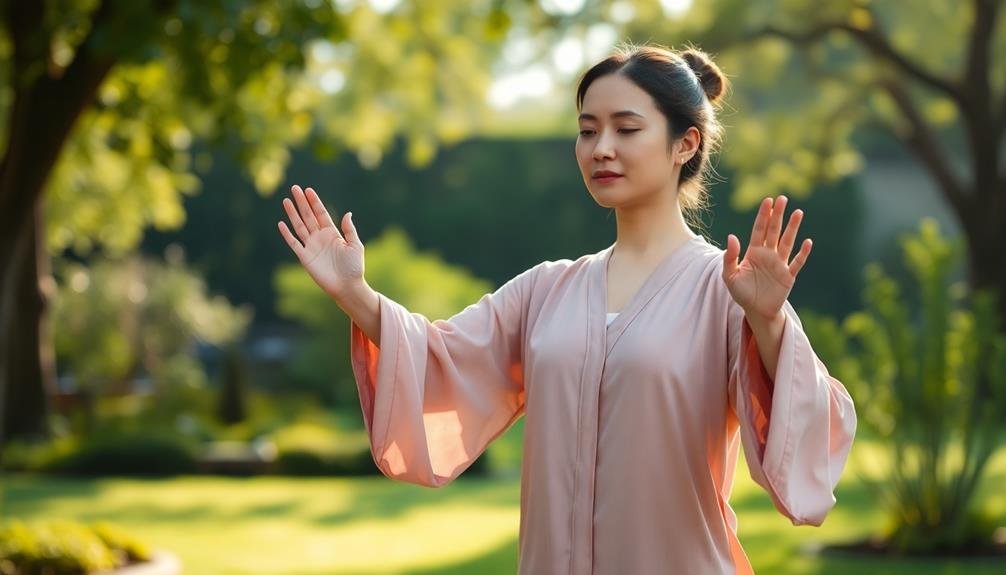In this anxiety-busting video guide, you'll discover gentle Qigong techniques to promote relaxation and inner calm. You'll learn essential breathing exercises like abdominal and counting breaths, along with simple movement sequences such as "Lifting the Sky" and "Pushing the Mountain." The guide combines these elements with mindfulness practices, helping you synchronize breath and motion for maximum benefit. You'll also find tips on incorporating Qigong into your daily routine, from morning breath work to quick stress-relief exercises during work breaks. By following this extensive guide, you'll gain valuable tools to manage anxiety and cultivate a harmonious balance between body and mind.
Understanding Qigong for Anxiety Relief

Rooted in ancient Chinese practices, Qigong offers a gentle yet powerful approach to managing anxiety. This mind-body technique combines slow, deliberate movements with controlled breathing and focused meditation to promote balance and harmony within your body and mind.
When you're feeling anxious, your body's stress response kicks in, triggering a cascade of physical and emotional reactions. Qigong helps counteract these effects by activating your parasympathetic nervous system, which promotes relaxation and calmness.
By practicing Qigong regularly, you'll learn to regulate your breathing, release tension, and cultivate a sense of inner peace.
One of the key benefits of Qigong for anxiety relief is its accessibility. You don't need special equipment or a high level of fitness to get started. The gentle, flowing movements can be adapted to suit various physical abilities, making it an excellent option for people of all ages and fitness levels.
As you practice Qigong, you'll develop greater body awareness and mindfulness. This increased self-awareness can help you identify early signs of anxiety and respond more effectively, preventing it from escalating into a full-blown panic attack.
Essential Breathing Techniques
At the core of Qigong practice, breathing techniques play an essential role in managing anxiety and promoting relaxation. These techniques help you focus on the present moment, calm your mind, and regulate your nervous system.
By mastering essential Qigong breathing methods, you'll equip yourself with powerful tools to combat anxiety in your daily life.
One of the most fundamental Qigong breathing techniques is abdominal breathing. To practice this, place one hand on your chest and the other on your belly. As you inhale, allow your belly to expand while keeping your chest relatively still. When exhaling, gently contract your abdominal muscles to push the air out. This technique encourages deeper, more relaxed breathing.
Here are three key Qigong breathing techniques to incorporate into your practice:
- Counting breath: Inhale for a count of four, hold for four, exhale for four, and pause for four.
- Ocean breath: Create a soft, oceanic sound in the back of your throat while breathing deeply.
- Alternate nostril breathing: Use your fingers to alternate between nostrils while inhaling and exhaling.
Gentle Movement Sequences

Gentle movement sequences form the backbone of Qigong practice, combining breath work with slow, fluid motions. These sequences help you cultivate mindfulness, improve balance, and enhance energy flow throughout your body. As you perform these movements, focus on your breath and maintain a relaxed, centered posture.
Begin with simple exercises like "Lifting the Sky" or "Pushing the Mountain." Stand with your feet shoulder-width apart, knees slightly bent. Inhale as you raise your arms slowly, then exhale as you lower them. Repeat this motion several times, allowing your body to find its natural rhythm.
Next, try the "Swimming Dragon" sequence. Start in a standing position, then shift your weight to one leg as you step forward with the other. Move your arms in a flowing, circular motion as if swimming through water. Alternate sides, maintaining a smooth, continuous flow.
| Sequence Name | Primary Benefits | Difficulty Level |
|---|---|---|
| Lifting the Sky | Releases tension, improves posture | Beginner |
| Pushing the Mountain | Builds core strength, enhances stability | Beginner |
| Swimming Dragon | Increases flexibility, promotes relaxation | Intermediate |
| Eight Pieces of Brocade | All-encompassing full-body workout | Advanced |
As you progress, you'll discover more complex sequences that target specific areas of your body and mind.
Mindfulness and Meditation Practices
Mindfulness and meditation practices complement the physical aspects of Qigong, enhancing its overall benefits. These practices focus on cultivating awareness, calming the mind, and promoting inner peace.
As you engage in Qigong, you'll learn to integrate mindfulness into your movements, creating a harmonious balance between body and mind.
To incorporate mindfulness and meditation into your Qigong practice:
- Begin with a short meditation: Sit comfortably, close your eyes, and focus on your breath for a few minutes before starting your physical routine.
- Practice mindful breathing: During your Qigong movements, pay attention to your breath, synchronizing it with your actions.
- End with a body scan: After completing your exercises, lie down and mentally scan your body from head to toe, releasing any remaining tension.
Incorporating Qigong Into Daily Life

Integrating Qigong into your daily routine doesn't require drastic changes or lengthy sessions. You can start by incorporating simple exercises into your existing schedule. Begin your day with a five-minute breathing exercise while still in bed, focusing on deep, slow breaths to energize your body and mind.
During work breaks, stand up and perform gentle stretches or practice a short Qigong sequence. This'll help relieve tension and improve circulation. When you're feeling stressed, take a moment to practice the "Shake It Off" technique, gently shaking your limbs to release tension and negative energy.
Before bedtime, try the "Standing Like a Tree" pose for a few minutes to ground yourself and promote relaxation. You can also incorporate Qigong principles into everyday activities, like mindfully washing dishes or walking with awareness of your body's movements.
Set reminders on your phone or place sticky notes around your home to prompt regular practice. As you become more comfortable with Qigong, gradually increase the duration and frequency of your sessions.
Frequently Asked Questions
Can Qigong Be Practiced During Pregnancy?
Yes, you can practice qigong during pregnancy. It's generally safe and beneficial, but you should consult your healthcare provider first. Modify certain exercises as needed, especially those involving deep abdominal breathing or intense physical movements. Always listen to your body.
Are There Any Age Restrictions for Practicing Qigong?
There aren't strict age restrictions for practicing qigong. You can start at any age, from children to seniors. However, you'll want to choose age-appropriate exercises and consult your doctor if you have health concerns or limitations.
How Long Does It Take to See Results From Qigong Practice?
You'll likely notice some immediate effects after practicing qigong, like reduced stress. However, for significant results, aim to practice regularly for at least 8-12 weeks. Remember, everyone's experience is unique, so be patient with your progress.
Can Qigong Be Combined With Other Forms of Exercise or Therapy?
Yes, you can combine qigong with other exercises or therapies. It's versatile and complements activities like yoga, tai chi, or meditation. You'll find it easily integrates into your fitness routine or enhances traditional medical treatments for holistic health benefits.
Are There Any Potential Side Effects or Risks Associated With Qigong?
While qigong is generally safe, you might experience mild dizziness or fatigue when starting out. If you have existing health conditions, it's best to consult your doctor before beginning. Don't push yourself too hard during practice.
In Summary
You've now learned valuable qigong techniques to combat anxiety. Remember, consistency is key. Start with simple breathing exercises, then gradually incorporate gentle movements and mindfulness practices into your routine. Don't be discouraged if you don't see immediate results; qigong's benefits build over time. Make it a habit to practice for a few minutes each day, and you'll soon notice improvements in your anxiety levels and overall well-being. Keep exploring and adapting these techniques to suit your needs.





Leave a Reply